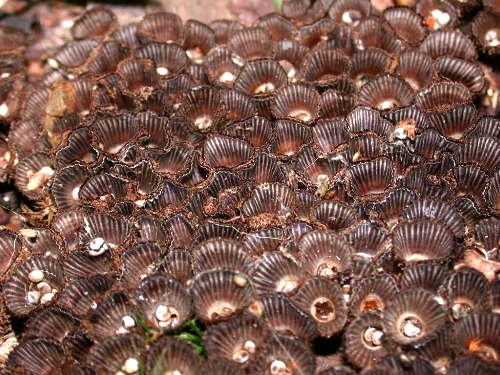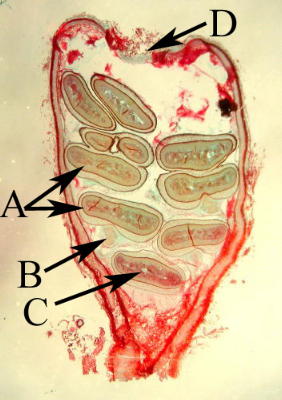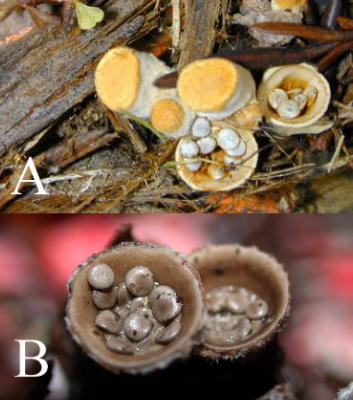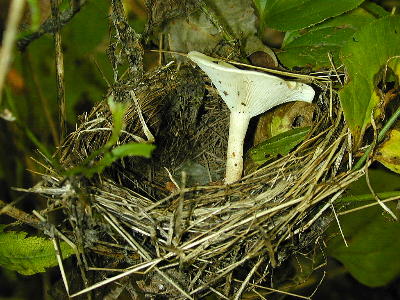Please click
TomVolkFungi.net for the rest of Tom Volk's pages on fungi
 This month's fungus is another common inhabitant of bark or wood mulch. Although less than a centimeter in diameter, Cyathus striatus often grows in huge clusters, thus making them easily visible, even from some distance. They're cute little fungi, almost always found wherever there is wood, as long as you look hard enough.
The common name "bird's nest fungus" should be obvious to anyone looking at the small mass of "eggs" within the small "nests" or cups of the fruiting bodies. The "eggs" in the nest contain the basidiospores within them.
These eggs (technically called peridioles) are actually analogous to tiny puffballs (like Lycoperdon or Calvatia gigantea) in that they contain the basidiospores inside of them. The basidiospores are borne on small basidia that line the small chambers inside of the eggs. However, the spores are not forcibly ejected from the basidia as they are in Agaricus, Amanita, Boletus, and almost all of the mushroom formers.
This month's fungus is another common inhabitant of bark or wood mulch. Although less than a centimeter in diameter, Cyathus striatus often grows in huge clusters, thus making them easily visible, even from some distance. They're cute little fungi, almost always found wherever there is wood, as long as you look hard enough.
The common name "bird's nest fungus" should be obvious to anyone looking at the small mass of "eggs" within the small "nests" or cups of the fruiting bodies. The "eggs" in the nest contain the basidiospores within them.
These eggs (technically called peridioles) are actually analogous to tiny puffballs (like Lycoperdon or Calvatia gigantea) in that they contain the basidiospores inside of them. The basidiospores are borne on small basidia that line the small chambers inside of the eggs. However, the spores are not forcibly ejected from the basidia as they are in Agaricus, Amanita, Boletus, and almost all of the mushroom formers.
 Besides being cute, the shape of the bird's nest is actually functional! The nest acts as a splash cup. When raindrops fall into the cup, the eggs are splashed out some distance away from the nest. If they land on a suitable substrate, they will germinate and form new mycelium that can grow into new fruiting bodies. When immature, the nest is covered by a brown membrane called an epiphragm, which eventually breaks down, usually my mechanical or microbial degradation. This opens up the "cup," and the rain can splash out the eggs. Once that happens, there is a thread, called a funiculus, attached to each peridiole that follows the egg on its watery journey. There is also a little "weight" called a hapteron on the end of each funiculus. [These mycologists seem to have a name for every little piece of every single fungus. sheesh...] When the peridiole hits a substrate, the funiculus wraps around the substrate, "powered" by the centripetal force of the hapteron. If all goes well, the peridiole becomes attached to its new wooden substrate when the spores germinate and invade the wood. The image to the right shows these various parts of a cross section of a splash cup of Cyathus. A=peridioles (eggs), B=funiculus and hapteron (cord and anchor) C=glebal chamber lined with basidia D=epiphragm (covering of the young splash cup).
This procedure sounds pretty complicated, but it must work pretty well, given the large masses of these fruiting bodies on wood everywhere.
Besides being cute, the shape of the bird's nest is actually functional! The nest acts as a splash cup. When raindrops fall into the cup, the eggs are splashed out some distance away from the nest. If they land on a suitable substrate, they will germinate and form new mycelium that can grow into new fruiting bodies. When immature, the nest is covered by a brown membrane called an epiphragm, which eventually breaks down, usually my mechanical or microbial degradation. This opens up the "cup," and the rain can splash out the eggs. Once that happens, there is a thread, called a funiculus, attached to each peridiole that follows the egg on its watery journey. There is also a little "weight" called a hapteron on the end of each funiculus. [These mycologists seem to have a name for every little piece of every single fungus. sheesh...] When the peridiole hits a substrate, the funiculus wraps around the substrate, "powered" by the centripetal force of the hapteron. If all goes well, the peridiole becomes attached to its new wooden substrate when the spores germinate and invade the wood. The image to the right shows these various parts of a cross section of a splash cup of Cyathus. A=peridioles (eggs), B=funiculus and hapteron (cord and anchor) C=glebal chamber lined with basidia D=epiphragm (covering of the young splash cup).
This procedure sounds pretty complicated, but it must work pretty well, given the large masses of these fruiting bodies on wood everywhere.

Although they are cup shaped, bird's nest fungi are not related to cup fungi such as morels, false morels, scarlet cups, eyelash cups, and black tulip fungi, all of which are members of the Ascomycota. These Ascomycota have their sexual spores, the ascospores, contained within small sacs called asci. These ascospores are usually forcibly ejected by the ascus. However in the puffballs and bid's nests, there are chambers in the gleba (flesh) of the fruiting body. Lining the inside of these chambers are basidia that bear basidiospores. In most cases the basidiospores merely fall off the basidium and wait for some external force to spread the spores around.
The bird's nest fungi are members of the Gasteromycetes, an unnatural grouping of basidiomycete fungi in which the basidia mature inside an enclosed area before the fruiting body is mature. This is an unnatural group, because we now know, through DNA analysis, that the Gasteromycetes really belong to many other evolutionary or phylogenetic groups. For example, the true puffballs (Lycoperdales, e.g. Lycoperdon pyriforme and Calvatia gigantea) seem to be rather closely related evolutionarily to members of the genus Agaricus, which includes the pizza mushroom, Agaricus bisporus, and the Prince, Agaricus augustus. Other Gasteromycetes (literally, "stomach fungi") include the stinkhorns, and the false puffballs, such as Pisolithus, the dog turd fungus. Another member of this group is the cannonball fungus Sphaerobolus stellatus, which is much smaller than the bird's nest fungi and contains only a single peridiole that is shot out of the small nest by a trampoline-like mechanism.
 I hope you enjoyed learning about the cute little bird's nest fungus, Cyathus striatus and its relatives.
I hope you enjoyed learning about the cute little bird's nest fungus, Cyathus striatus and its relatives. Look for this fungus in your bark or wood mulch right now! I bet you'll find it there, although it's much more common in the fall. But the spring is certainly the time of year when other kinds of birds are making their nests in our part of the world. See if you can find it-- it's more common than you might think!
If you have anything to add, or if you have corrections, comments, or recommendations for future FotM's (or maybe you'd like to be co-author of a FotM?), please write to me at 
This page and other pages are © Copyright 2006 by Thomas J.
Volk, University of Wisconsin-La Crosse.
Learn more about fungi! Go to Tom Volk's Fungi Home Page --TomVolkFungi.net
Return to Tom Volk's Fungus of the month pages listing